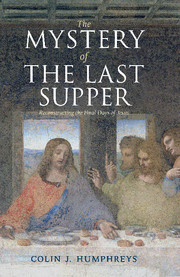Book contents
- Frontmatter
- Contents
- List of illustrations
- Foreword by I. Howard Marshall
- Acknowledgements
- 1 Four mysteries of the last week of Jesus
- 2 Dating the crucifixion – the first clues
- 3 The problem of the last supper
- 4 Can we reconstruct the Jewish calendar at the time of Christ?
- 5 The date of the crucifixion
- 6 The moon will be turned to blood
- 7 Did Jesus use the solar calendar of Qumran for his last supper Passover?
- 8 Does ancient Egypt hold a key to unlocking the problem of the last supper?
- 9 Discovering the lost calendar of ancient Israel
- 10 Was the lost ancient Jewish calendar used in Israel at the time of Jesus?
- 11 The date of the last supper: the hidden clues in the gospels
- 12 From the last supper to the crucifixion: a new analysis of the gospel accounts
- 13 A new reconstruction of the final days of Jesus
- Notes
- Bibliography
- Index of biblical and other ancient sources
- General index
3 - The problem of the last supper
Published online by Cambridge University Press: 03 May 2011
- Frontmatter
- Contents
- List of illustrations
- Foreword by I. Howard Marshall
- Acknowledgements
- 1 Four mysteries of the last week of Jesus
- 2 Dating the crucifixion – the first clues
- 3 The problem of the last supper
- 4 Can we reconstruct the Jewish calendar at the time of Christ?
- 5 The date of the crucifixion
- 6 The moon will be turned to blood
- 7 Did Jesus use the solar calendar of Qumran for his last supper Passover?
- 8 Does ancient Egypt hold a key to unlocking the problem of the last supper?
- 9 Discovering the lost calendar of ancient Israel
- 10 Was the lost ancient Jewish calendar used in Israel at the time of Jesus?
- 11 The date of the last supper: the hidden clues in the gospels
- 12 From the last supper to the crucifixion: a new analysis of the gospel accounts
- 13 A new reconstruction of the final days of Jesus
- Notes
- Bibliography
- Index of biblical and other ancient sources
- General index
Summary
And he [Jesus] said to them [his disciples at the last supper], ‘I have eagerly desired to eat this Passover with you before I suffer’… Then seizing him, they [the temple guard] led him away and took him into the house of the high priest [Caiaphas].
(Luke 22:15, 54)Then the Jews led Jesus from Caiaphas to the palace of the Roman governor. By now it was early morning, and to avoid ceremonial uncleanness the Jews did not enter the palace; they wanted to be able to eat the Passover.
(John 18:28)These passages from Luke and John strikingly illustrate the problem of the time and nature of the last supper. The verse from John seems to follow on from the verses from Luke, except that the Feast of Passover has been shifted from before the arrest and trials of Jesus to after these events. If Jesus had already eaten the Passover with his disciples before his arrest and trials (Luke, and also Matthew and Mark), how was it that the Jews were still waiting to eat the Passover after his arrest and trials (John)? This looks like a straight contradiction and, as I have written earlier, it has puzzled biblical scholars for centuries. In this chapter we will examine some of the solutions that have been proposed. First, I want to explore in detail the apparent disagreement between the gospels about the last supper.
- Type
- Chapter
- Information
- The Mystery of the Last SupperReconstructing the Final Days of Jesus, pp. 26 - 38Publisher: Cambridge University PressPrint publication year: 2011

